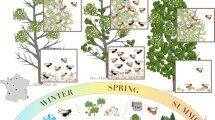Summary
I examined the germination characteristics of weed and outcrop populations of Crepis tectorum to test the hypothesis that the presumably more ephemeral weed habitat favors the highest levels of seed dormancy. The winter annual habit characterizing most plants of this species was reflected in a rapid germination of seeds sown in late summer. A slightly higher fraction of surface-sown seeds of weed plants delayed germination. Buried seeds of weed plants also survived better than seeds produced by plants in most outcrop populations, supporting the idea that weediness favors seed dormancy and a persistent seed bank. However, the differences in seed dormancy between the two ecotypes were small and not entirely consistent. Furthermore, high levels of seed dormancy were induced during burial in the outcrop group, suggesting that there is a potential for a dormant seed population in this habitat as well. Demographic data from one of the outcrop populations verified the presence of a large between-year seed bank. Possible environmental factors favoring seed dormancy in outcrop populations are discussed. The unusually large seeds of weedy Crepis contrasts with the relatively small difference in seed dormancy between the two ecotypes.
Similar content being viewed by others
References
Andersson S (1989a) Variation in heteroblastic succession among populations of Crepis tectorum. Nord J Bot 8:565–573
Andersson S (1989b) Life-history variation in Crepis tectorum. Oecologia 80:540–545
Babcock EB (1947) The genus Crepis 1–2. Univ. of California press, Berkeley and Los Angeles
Baker HG (1974) The evolution of weeds. Ann Rev Ecol Syst 5:1–24
Cohen D (1966) Optimizing reproduction in a randomly varying environment. J Theor Biol 12:119–129
CookR (1980) The biology of seeds in the soil. In: SolbrigOT (ed) Demography and evolution in plant populations. Blackwell Oxford, pp 107–188
Darwent AL, McKenzie JS (1978) Effects of planting date on the growth and development of narrow-leaved hawk's-beard. Can J Plant Sci 58:1087–1094
Freas KE, Kemp PR (1983) Some relationships between environmental reliability and seed dormancy in desert annual plants. J Ecol 71:211–217
Harper JL (1977) Population biology of plants. Academic Press, New York
Harper JL, Lovell PH, Moore KG (1970) The shapes and sizes of seeds. Ann Rev Ecol Syst 1:327–356
Klemow KM, Raynal DJ (1983) Population biology of an annual plant in a temporally variable habitat. J Ecol 71:691–703
Leverich WJ, Levin DA (1979) Age-specific survivorship and reproduction in Phlox drummondi. Am Nat 113:881–903
Mack RN (1976) Survivorship of Cerastium atrovirens at Aberffraw, Anglesey. J Ecol 64:309–312
Palmblad IG (1969) Population variation in germination of weedy species. Ecology 50:746–748
Pettersson B (1958) Dynamik och konstans i Gotlands flora och vegetation. Acta Phytogeogr Suec 40
Regehr DL, Bazzaz FA (1979) The population dynamics of Erigeron canadensis, a successional winter annual. J Ecol 67:923–933
Rosén E (1984) Some short-term changes in the dynamics of limestone grasslands of South Öland, Sweden. Nova Acta R Soc Scient Upsal Serie V:C 3, pp 189–205
Sterner R (1938) Flora der Insel Öland. Acta Phytogeogr Suec 9:1–169
Thompson K, Grime JP (1979) Seasonal variation in the seed banks of herbaceous species in ten contrasting habitats. J Ecol 67:893–921
Venable DL, Brown JS (1988) The selective interactions of dispersal, dormancy, and seed size as adaptations for reducing risk in variable environments. Am Nat 131:360–384
Watkinson AR (1978) The demography of a sand dune annual: Vulpia fasciculata. II. The dynamics of seed populations. J Ecol 66:35–44
Westoby M (1981) How diversified seed germination behavior is selected. Am Nat 118:882–885
Author information
Authors and Affiliations
Rights and permissions
About this article
Cite this article
Anderson, S. The relationship between seed dormancy, seed size and weediness, in Crepis tectorum (Asteraceae). Oecologia 83, 277–280 (1990). https://doi.org/10.1007/BF00317765
Received:
Accepted:
Issue Date:
DOI: https://doi.org/10.1007/BF00317765




